Last week some unseasonal showers reached Yosemite. The showers didn’t bring heavy amounts of precipitation, but enough snow fell at higher elevations to temporarily close Tioga Pass and the Glacier Point Road.
On Thursday the Tioga Road reopened. Since Claudia and I are heading up to the northern coast of California soon for my redwoods workshop, we thought this might be our last chance to go up to the Yosemite high country for awhile, so we decided to drive up to Tuolumne Meadows for the afternoon. There were still some clouds and showers in the area, so the prospect of some interesting weather made the idea even more enticing.
Upon reaching Tuolumne Meadows we found a large bank of clouds moving in from the east. Soon those clouds were overhead, Mt. Dana and Mt. Gibbs became enveloped in a snow squall, and most of the light was gone.
But there were clear patches of sky to the west, and some interesting cloud formations in that direction. I suddenly remembered a photograph I took at least ten years ago from a pond in the meadows, looking west toward some similar clouds. So I went to the same area, and found a composition with clouds reflected in the water, and Fairview Dome on the left side of the frame (you’ll find both the old and new photographs below).
Then the sky closed up completely, and a few snowflakes filtered down. Most of the snow squall passed by to the north, and the clouds gradually cleared again. It looked like the sun might break through and strike Mt. Dana and Mt. Gibbs, so I moved further west to another pond that I’d been to before, where the peaks would be reflected in the water.
Sure enough, the sun did break through and hit the peaks. And then the clouds looked interesting again to the west, so I moved to the other side of this same pond to get a western view. The sun appeared through the clouds just above a small ridge, and I remembered that I’d been to a similar spot before too, many years ago, at the same time of day, and had put the sun behind a tree that stuck out above the ridge (the last photo below). So I did that again (the photograph at the top of this post). The conditions were different, and the resulting photographs quite dissimilar, but the location and idea were the same.
About five minutes after the sun dropped below the ridge, the light started to look interesting again in the other direction – toward the high peaks of Mounts Dana and Gibbs. So I ran (literally) around the pond again to capture that golden light on the mountains reflected in the water.
All this reminded me of how valuable it is to know an area well. Of course, I’m very lucky to live near a place like Yosemite. But everyone lives near someplace interesting. Even if you prefer natural areas, like me, it’s amazing how many beautiful natural landscapes can be found within a short drive of some of the most heavily populated urban areas in the country. Although many people wouldn’t consider these spots to be as spectacular as Yosemite, they probably haven’t been photographed as much as Yosemite either, which means the untapped photo potential might be even richer. And every place gets spectacular light sometimes — and light is usually more important than the subject.
Also, experience gained at one place can often be applied at another. If you put the sun at your back while looking at the spray of a waterfall in Georgia, or Tennessee, or New York, you’re likely to see a rainbow. The same thing works on waterfalls in Yosemite, or Yellowstone, or Iceland.
And ponds and lakes make great foregrounds anywhere. If you photograph a pond at your local park under varying light and weather conditions, you might make some great photographs, and also learn how to photograph lakes and ponds in more exotic locations.
People photograph best what they know best. Get to know one place well and your photographs will show it. And the more experience you gain in one location, the more likely you are to have one of those déjà-vu moments where you realize that you’ve photographed something similar before – and you know what to do.
– Michael Frye
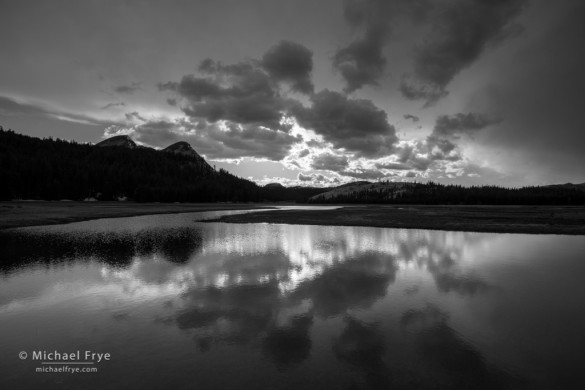
Clouds and reflections, Tuolumne Meadows, 6:40 p.m. (as the snow squall was approaching from the other direction)
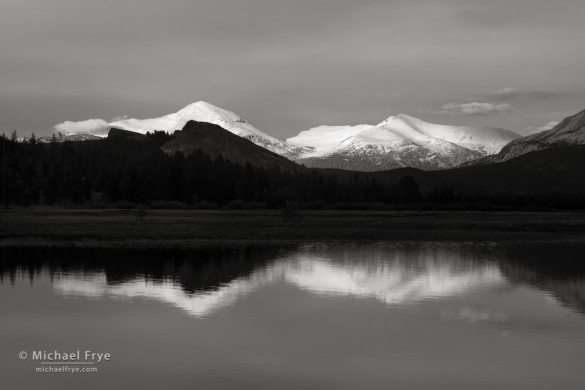
Mt. Dana and Mt. Gibbs reflected in a snowmelt pond, Tuolumne Meadows, 7:19 p.m. (after the snow squall)
Did you like this article? Click here to subscribe to this blog and get every new post delivered right to your inbox!
Michael Frye is a professional photographer specializing in landscapes and nature. He is the author or principal photographer of The Photographer’s Guide to Yosemite, Yosemite Meditations, Yosemite Meditations for Women, and Digital Landscape Photography: In the Footsteps of Ansel Adams and the Great Masters. He has also written three eBooks: Light & Land: Landscapes in the Digital Darkroom, Exposure for Outdoor Photography, and Landscapes in Lightroom 5: The Essential Step-by-Step Guide. Michael written numerous magazine articles on the art and technique of photography, and his images have been published in over thirty countries around the world. Michael has lived either in or near Yosemite National Park since 1983, currently residing just outside the park in Mariposa, California.

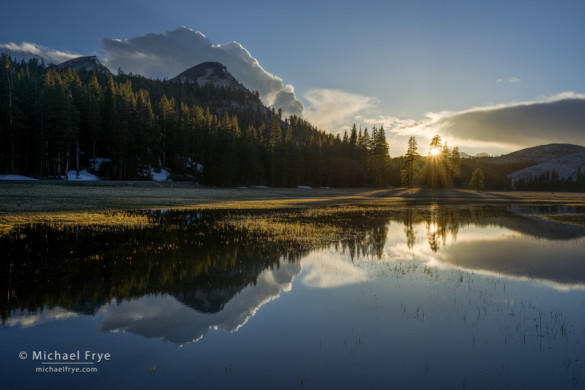
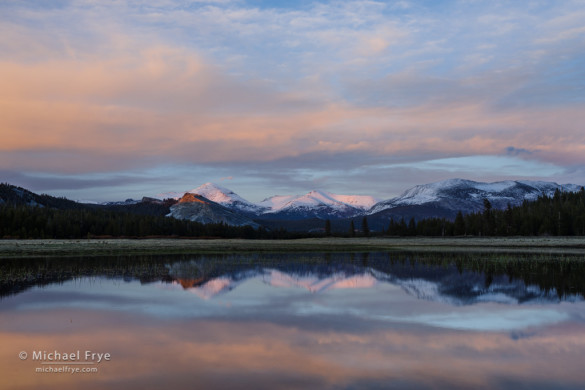
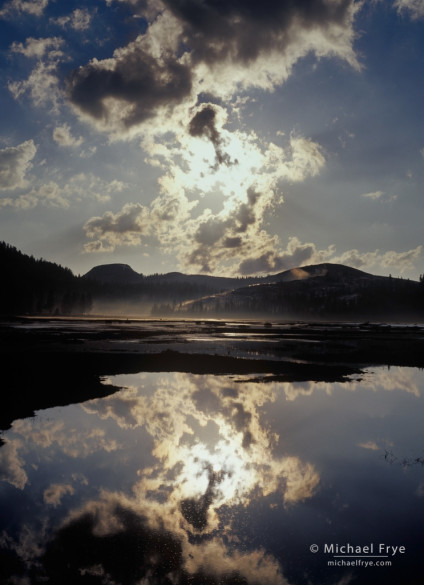
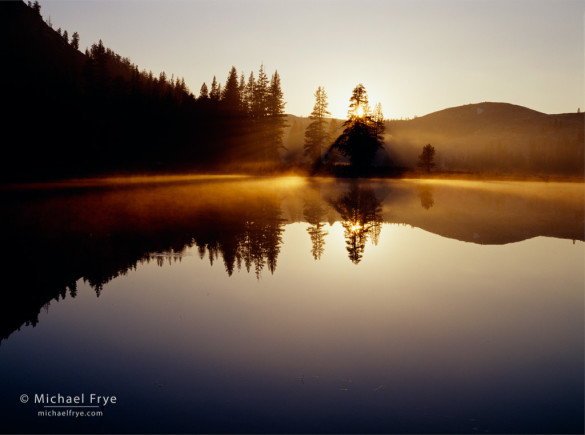








Another beautiful series of images Michael. I really love all of them, so hard to prefer one over the other, which is so great that I do not, I can just enjoy them all.
Thanks very much Richard – I really appreciate it!
Michael,
Excellent as always! You are so correct about lighting being more important than the subject and that there are interesting images to be made close to all of us.
The format of the new photos appears to be 16:9. Did you use your Sony A7r? If I’m not mistaken, that is the only ratio that is available on that camera. (Correct me if I’m wrong.)
Thanks James! Yes, I used the Sony A7r for these photos, but the aspect ratio for the camera is 2:3, just like every other full-frame camera.
Your pictures inspire me, not only because I am a beginner photographer but because my ancestors traveled that land between Yosemite and Mono Lake. I was just in the valley around Mothers Day and purchased one of your books. I am really interested in the LR book and want to purchase that one too. Still need to learn a lot about camera settings to capture the light. Would love to take a workshop.
Debbie Walker
Thanks so much Debbie. It would be great to see you in a workshop sometime, and let me know if you have any questions about the Lightroom ebook.
I highly recommend the ebook. I have found it one of the best resources for landscape photography processing. Having access to the same raw files really helps you “see” what you are doing. Terrific book. Thank you Michael.
Thanks John – I’m glad you found the ebook helpful!
Lovely, well composed photos! You did pick a spectacular day to visit the Tuolumne area. I always enjoy photos that reflect mirror images (lol, not referring to apps that do it for you!)
Thank you Ann, and I must like reflections too, since I photograph so many of them. 🙂
Thank Michael,
As I continue trying to improve my photography, I’ve begun to think that I should spend more time on fewer locations in order to really get the know and feel of them.
I reside in the Washington D.C. area and cannot begin to express how envious I am of photographers who live near some of the “great” national parks out west. Still, I remind myself that there is natural beauty everywhere and part of my job as a photographer is to find it and capture it.
Thanks!
A.P.
A.P. – Having just visited the Smokies, Blue Ridge Parkway, and other places in the southern Appalachians, I know that there’s lots of natural beauty not too far from you. These landscapes are not as dramatic as some places out west, but can be just as photogenic. I think compositions in these more subtle landscapes are often less obvious, but that can force you to develop your eye, which is a good thing.